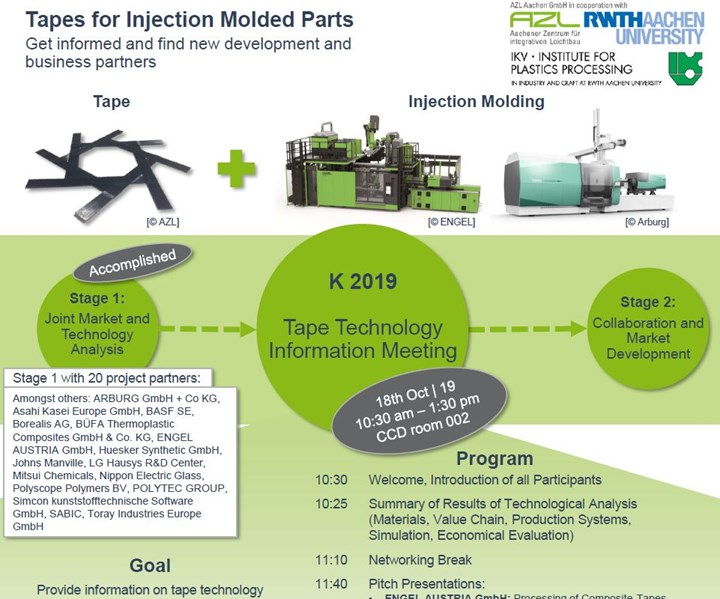Research project reports potential for tape inserts in injection molding
The research consortium, led by the Aachen Center for Integrative Lightweight Production and the Institute for Plastics Processing at RWTH Aachen University, will present its results at K 2019.
Share

Results of the study will be presented at K 2019 in October. Source | AZL Aachen GmbH
Tape inserts reportedly offer significant potential for injection molding parts, according to the results of a recent project conducted by a consortium led by the Aachen Center for Integrative Lightweight Production (AZL, Aachen, Germany) and the Institute for Plastics Processing at RWTH Aachen University (IKV, Aachen).
In cooperation with 20 industrial partners, AZL and IKV carried out a detailed analysis of tape inserts in injection molded components over a period of eight months. The tapes, which are a few tenths of a millimeter thick, are continuous fibers, typically made of glass or carbon, completely impregnated and embedded in a thermoplastic matrix. The tapes can be precisely aligned to the loads in a component and are used primarily in high-performance applications with the aim of weight reduction. The aim of the conducted analysis was the identification of potential applications and the estimation of a wider range of applications.
The project was divided into several phases: Phase I was used to identify the current status. In 20 interviews with representative companies of the injection molding industry, the researchers gathered why tape inserts have rarely been taken into account so far, when defining the material concepts to be analyzed. The lack of information about the material class, the procedure and tools for the development process and the necessary production technologies were cited as major challenges. Based on the status quo, the researchers developed a methodology for analyzing the technological and economic potential of tape inserts in injection molding applications.
“Our analysis clearly underlined the potential of the tape inserts. With them, the material performance can be increased. Therefore, component costs can be saved by using cheaper injection molding compounds or less material or by optimizing the cycle time of the production process,
says Dr. Michael Emonts. “It is also advantageous that the process sequence with tape inserts is certainly comparable with in-mold labeling processes, so that some existing automation technology can be used.”
“We are so satisfied with the progress and results of the study that we have already defined several follow-up projects and are also forming a consortium for the short-term identification and implementation of new applications,” says Prof. Christian Hopmann, founding professor of the AZL and head of the IKV. The results of the previous study and follow-up project plans will be presented at K 2019 on Oct. 18.
Consortium members include Asahi Kasei Europe GmbH (Düsseldorf, Germany), BASF SE (Ludwigshafen, Germany), Borealis AG (Vienna, Austria), BÜFA Thermoplastic Composites GmbH & Co. KG (Rastede, Niedersachsen, Germany), ENGEL AUSTRIA GmbH (Schwertberg, Austria), Huesker Synthetic GmbH (Gescher, Germany), LG Hausys R&D Center, Mitsui Chemicals (Düsseldorf, Germany), Nippon Electric Glass (Otsu, Japan), Polyscope Polymers BV (Geleen, Netherlands), Polytec Group (Kraichtal-Gochsheim, Germany), Simcon kunststofftechnische Software GmbH (Würselen, Germany), SABIC (Pittsfield, Mass., U.S.) and Toray International Europe GmbH (Neu-Isenburg, Germany).
Related Content
-
Large-format 3D printing enables toolless, rapid production for AUVs
Dive Technologies started by 3D printing prototypes of its composite autonomous underwater vehicles, but AM became the solution for customizable, toolless production.
-
Carbon fiber, bionic design achieve peak performance in race-ready production vehicle
Porsche worked with Action Composites to design and manufacture an innovative carbon fiber safety cage option to lightweight one of its series race vehicles, built in a one-shot compression molding process.
-
A new era for ceramic matrix composites
CMC is expanding, with new fiber production in Europe, faster processes and higher temperature materials enabling applications for industry, hypersonics and New Space.

.jpg;width=70;height=70;mode=crop)










.jpg;maxWidth=300;quality=90)



